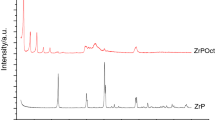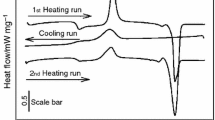Abstract
Poly(ε-caprolactone) (PCL)/polyamide 6 (PA6) composites were fabricated by dispersing PA6 powder into PCL. The SEM results show good dispersion of PA6 in the PCL matrix. Crystallization behavior, crystal structure and spherulitic morphology of pure PCL and the PCL/PA6 composites, as well as their thermal stability and dynamic mechanical properties, were characterized using various techniques including differential scanning calorimeter, X-ray diffraction (XRD), polarized light microscope (PLM), thermal gravimetric analysis (TGA) and dynamic mechanical analyzer (DMA). The PCL/PA6 composite showed increased storage modulus and glass transition temperature (Tg). PA6 powder functions as a heterogeneous nucleate to promote PCL crystallization but does not alter orthorhombic crystal form, crystallization mechanism and thermal stability of PCL.









Similar content being viewed by others
References
Gross RA, Kalra B (2002) Biodegradable polymers for the environment. Science 297(5582):803–807
Laycock B, Nikolić M, Colwell JM et al (2017) Lifetime prediction of biodegradable polymers. Prog Polym Sci 71:144–189
Woodruff MA, Hutmacher DW (2010) The return of a forgotten polymer-polycaprolactone in the 21st century. Prog Polym Sci 35:1217–1256
Eastmond G (1999) Poly(ε-caprolactone) blends. Adv Polym Sci 149:59–223
Qiao X, Li W, Sun K et al (2009) Isothermal crystallization kinetics of silk fibroin fiber-reinforced poly(ε-caprolactone) biocomposites. Polym Int 58:530–537
Liang J, Zhou L, Tang C (2013) Crystallization properties of polycaprolactone composites filled with nanometer calcium carbonate. J Appl Polym Sci 128(5):2940–2944
Azevedo MC, Reis RL, Claase MB et al (2003) Development and properties of polycaprolactone/hydroxyapatite composite biomaterials. J Mater Sci Mater M 14:103–107
Hajiali F, Tajbakhsh S, Shojaei A (2018) Fabrication and properties of polycaprolactone composites containing calcium phosphate-based ceramics and bioactive glasses in bone tissue engineering: A review. Polym Rev 58(1):1–44
Harrane A, Belbachir M (2007) Synthesis of biodegradable polycaprolactone/montmorillonite nanocomposites by direct in-situ polymerization catalyzed by exchanged clay. Macromol Symp 247:379–384
Sayyar S, Murray E, Thompson BC et al (2013) Covalently linked biocompatible graphene/polycaprolactone composites for tissue engineering. Carbon 52:296–304
Chin SJ, Doherty M, Vempati S et al (2019) Solvothermal synthesis of graphene oxide and its composites with poly(ε-caprolactone). Nanoscale 11:18672–18682
Zhuravlev E, Wurm A, Potschke P et al (2014) Kinetics of nucleation and crystallization of poly(ε-caprolactone)-multiwalled carbon nanotube composites. Eur Polym J 52:1–11
Vacková T, Kratochvíl J, Ostafinska A et al (2017) Impact of particle morphology on structure, crystallization kinetics, and properties of PCL composites with TiO2-based particles. Polym Bull 74:445–464
Guan W, Qiu Z (2012) Isothermal crystallization Kinetics, morphology, and dynamic mechanical properties of biodegradable poly(ε-caprolactone) and octavinyl-polyhedral oligomeric silsesquioxanes nanocomposites. Ind Eng Chem Res 51:3203–3208
Ali Akbari Ghavimi S, Ebrahimzadeh MH, SolatiHashjin M et al (2015) Polycaprolactone/starch composite: Fabrication, structure, properties, and applications. J Biomed Mater Res Part A 103:2482–2498
Cai J, Xiong Z, Zhou M et al (2014) Thermal properties and crystallization behavior of thermoplastic starch/poly(ε-caprolactone) composites. Carbohyd Polym 102:746–754
Zhang H, Luo X, Lin X et al (2016) Polycaprolactone/chitosan blends: simulation and experimental design. Mater Design 90:396–402
Wu CS (2004) Analysis of mechanical, thermal, and morphological behavior of polycaprolactone/wood flour blends. J Appl Polym Sci 94:1000–1006
Aguiar VO, Marques MFV (2016) Composites of polycaprolactone with cellulose fibers: morphological and mechanical evaluation. Macromol Symp 367(1):101–112
Bai Y, Jiang C, Wang Q et al (2013) A novel high mechanical strength shape memory polymer based on ethyl cellulose and polycaprolactone. Carbohyd Polym 96(2):522–527
Boujemaoui A, Cobo Sanchez C, Engström J, Bruce C et al (2017) Polycaprolactone nanocomposites reinforced with cellulose nanocrystals surface-modified via covalent grafting or physisorption-A comparative study. ACS Appl Mater Interfaces 9(40):35305–35318
Lönnberg H, Larsson K, Lindstrom T et al (2011) Synthesis of polycaprolactone-grafted microfibrillated cellulose for use in novel bionanocomposites-influence of the graft length on the mechanical properties. ACS Appl Mater Interfaces 3(5):1426–1433
Sanlı S, Durmus A, Ercan N (2012) Effect of nucleating agent on the nonisothermal crystallization kinetics of glass fiber- and mineral-filled polyamide-6 composites. J Appl Polym Sci 125:E268–E281
Richardson NE, Meakin BJ (1974) The sorption of benzocaine from aqueous solution by nylon 6 powder. J Pharm Pharmac 26:166–174
Suteu D, Bilba D, Dan F (2007) Synthesis and characterization of polyamide powders for sorption of reactive dyes from aqueous solutions. J Appl Polym Sci 105:1833–1843
Chen Z, Liu C, Wang Q (2001) Solid-phase preparation of ultra-fine PA6 powder through pan-milling. Polym Eng Sci 41(7):1187–1195
Takahashi T, Inamura M, Tsujimoto I (1970) Epitaxial growth of polymer crystals on uniaxially drawn polymers. J Polym Sci Part B: Polym Lett 8:651–657
Avrami M (1940) Kinetics of phase change. II. Transformation-time relations for random distribution of nuclei. J Chem Phys 8:212–224
Avrami M (1941) Granulation, phase change, and microstructure kinetics of phase change. III J Chem Phys 9:177–184
Liu H, Huang Y, Yuan L et al (2010) Isothermal crystallization kinetics of modified bamboo cellulose/PCL composites. Carbohyd Polym 79:513–519
Acknowledgements
Funding support from the National Natural Science Foundation of China (21,204,018, U1204518, U1704144) and China Scholarship Council (201,708,410,015) is acknowledged.
Author information
Authors and Affiliations
Contributions
M.Q. Li and Y.D. Zhang contribute equally as co-first author
Corresponding authors
Ethics declarations
Conflict of interest
The authors declare no conflicts of financial or non-financial competing interest.
Additional information
Publisher's Note
Springer Nature remains neutral with regard to jurisdictional claims in published maps and institutional affiliations.
Rights and permissions
About this article
Cite this article
Li, M., Zhang, Y., Zhu, F. et al. Influence of PA6 particle filler on morphology, crystallization behavior and dynamic mechanical properties of poly(ε-caprolactone) as an efficient nucleating agent. J Polym Res 28, 461 (2021). https://doi.org/10.1007/s10965-021-02814-5
Received:
Accepted:
Published:
DOI: https://doi.org/10.1007/s10965-021-02814-5




